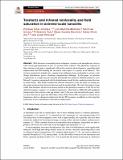| dc.contributor.author | Vidal-Codina, Ferran | |
| dc.contributor.author | Martín-Moreno, Luis | |
| dc.contributor.author | Ciracì, Cristian | |
| dc.contributor.author | Yoo, Daehan | |
| dc.contributor.author | Nguyen, Ngoc-Cuong | |
| dc.contributor.author | Oh, Sang-Hyun | |
| dc.contributor.author | Peraire, Jaime | |
| dc.date.accessioned | 2021-10-27T20:23:07Z | |
| dc.date.available | 2021-10-27T20:23:07Z | |
| dc.date.issued | 2020 | |
| dc.identifier.uri | https://hdl.handle.net/1721.1/135357 | |
| dc.description.abstract | © 2020 Optical Society of America under the terms of the OSA Open Access Publishing Agreement. With advances in nanofabrication techniques, extreme-scale nanophotonic devices with critical gap dimensions of just 1-2 nm have been realized. The plasmonic response in these extreme-scale gaps is significantly affected by nonlocal electrodynamics, quenching field enhancement and blue-shifting the resonance with respect to a purely local behavior. The extreme mismatch in lengthscales, ranging from millimeter-long wavelengths to atomic-scale charge distributions, poses a daunting computational challenge. In this paper, we perform computations of a single nanoslit using the hybridizable discontinuous Galerkin method to solve Maxwell’s equations augmented with the hydrodynamic model for the conduction-band electrons in noble metals. This method enables the efficient simulation of the slit while accounting for the nonlocal interactions between electrons and the incident light. We study the impact of gap width, film thickness and electron motion model on the plasmon resonances of the slit for two different frequency regimes: (1) terahertz frequencies, which lead to 1000-fold field amplitude enhancements that saturate as the gap shrinks; and (2) the near- and mid-infrared regime, where we show that narrow gaps and thick films cluster Fabry-Pérot (FP) resonances towards lower frequencies, derive a dispersion relation for the first FP resonance, in addition to observing that nonlocality boosts transmittance and reduces enhancement. | |
| dc.language.iso | en | |
| dc.publisher | The Optical Society | |
| dc.relation.isversionof | 10.1364/OE.386405 | |
| dc.rights | Article is made available in accordance with the publisher's policy and may be subject to US copyright law. Please refer to the publisher's site for terms of use. | |
| dc.source | OSA Publishing | |
| dc.title | Terahertz and infrared nonlocality and field saturation in extreme-scale nanoslits | |
| dc.type | Article | |
| dc.contributor.department | Massachusetts Institute of Technology. Department of Aeronautics and Astronautics | |
| dc.relation.journal | Optics Express | |
| dc.eprint.version | Final published version | |
| dc.type.uri | http://purl.org/eprint/type/JournalArticle | |
| eprint.status | http://purl.org/eprint/status/PeerReviewed | |
| dc.date.updated | 2021-05-03T17:59:41Z | |
| dspace.orderedauthors | Vidal-Codina, F; Martín-Moreno, L; Ciracì, C; Yoo, D; Nguyen, N-C; Oh, S-H; Peraire, J | |
| dspace.date.submission | 2021-05-03T17:59:42Z | |
| mit.journal.volume | 28 | |
| mit.journal.issue | 6 | |
| mit.license | PUBLISHER_POLICY | |
| mit.metadata.status | Authority Work and Publication Information Needed | |
